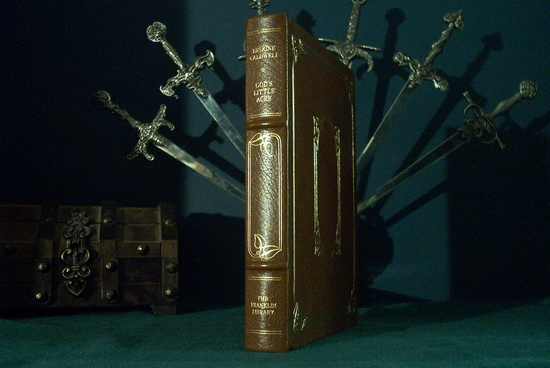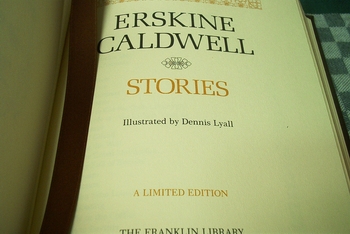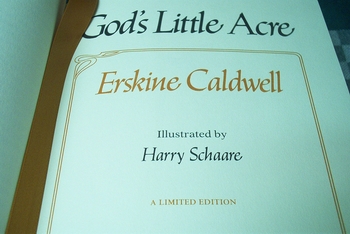Erskine Caldwell biography
Erskine (Preston) Caldwell, (1903 - 1987), American writer, born in White Oak, Ga., and educated at the universities of Virginia and Pennsylvania. Erskine Caldwell is the author of many short stories and novels describing the lives of the poor-white sharecroppers of the Southern States, particularly Georgia. Much of Erskine Caldwell's work is characterized by early humor and undertones of indignation at social injustice. Among Erskine Caldwell's works are the novelettes The Bastard (1929) and Poor Fool (1930); the books of short stories Kneel to the Rising Sun (1935), Southways (1938), Gulf Coast Stories (1956), and Erskine Caldwell's Men and Women (1961); the novels Tobacco Road (1932), God's Little Acre (1933), Georgia Boy (1943), Tragic Ground (1944), The Sure Hand of God (1947), Love and Money (1954), and Gretta (1955); the autobiography Call It Experience (1951); and the sociological work In Search of Bisco (1965). Dramatized (1933) by the American playwright and producer John Kirkland, Tobacco Road enjoyed one of the longest runs in the history of the American theater. Erskine Caldwell also wrote the text of books with photographs by the American photographer Margaret Bourke-White, notably You Have Seen Their Faces (1937), North of the Danube (1938), Shooting the Russian War (1942), and This Very Earth (1948).Franklin Library Erskine Caldwell books
God's Little Acre - signed limited edition -1979Collected Stories - collected stories of worlds greatest writers - 1980
Author Erskine Caldwell
Erskine Caldwell (1903-1987) was an American author best known for his novels and short stories that vividly depicted the harsh realities of Southern rural life during the early to mid-20th century. Born on December 17, 1903, in White Oak, Georgia, Caldwell grew up in poverty, an experience that profoundly influenced his later work. Caldwell's childhood was marked by the economic struggles of the South, and this backdrop became a central theme in much of his writing. After completing high school, he attended Erskine College in South Carolina, where he developed an interest in literature and began to explore his passion for writing.
In the 1930s, Caldwell gained national recognition with the publication of his most famous novel, Tobacco Road (1932). The novel, set during the Great Depression, exposed the destitution and despair faced by a poor Georgia farming family. Its raw portrayal of poverty, sexual themes, and controversial content led to censorship and bans in some areas, but it also catapulted Caldwell to literary fame. Following the success of Tobacco Road, Caldwell continued to produce a prolific body of work. Another notable novel, God's Little Acre (1933), further explored the hardships of Southern agrarian life and became another bestseller. Throughout his career, Caldwell's writing style was characterized by its stark realism, capturing the struggles, eccentricities, and complexities of rural Southern characters.
Tobacco Road is Erskine Caldwell's most famous and controversial novel, published in 1932. The book is a stark portrayal of poverty and social decay among a group of impoverished white sharecroppers in rural Georgia during the Great Depression. The novel's title refers to a fictional stretch of land where the Lester family, the central characters, live and struggle to survive. The Lester family, led by the patriarch Jeeter, is characterized by extreme poverty, ignorance, and a complete lack of ambition. The family members are depicted as living in squalor, with a dilapidated home and no means of improving their situation. Despite their dire circumstances, the characters exhibit a resilience and stubbornness that sometimes borders on the absurd. The novel is notable for its unflinching portrayal of taboo subjects such as sexuality, poverty, and the impact of economic hardship on individuals and families. Caldwell's use of dark humor and satire serves to highlight the absurdity of the characters' lives and the societal issues they face. Tobacco Road became an instant success but also faced significant controversy. Some critics praised Caldwell for his realistic depiction of rural poverty, while others accused him of perpetuating stereotypes and exploiting the hardships of the poor for sensationalism. The novel's explicit content led to censorship in some places, and it was even banned in Australia and Canada.
Despite the controversy, Tobacco Road remains an important work in American literature. It offers a critical commentary on the socio-economic conditions of the time and serves as a snapshot of the struggles faced by many during the Great Depression. Erskine Caldwell's novel continues to be studied and discussed for its impact on literature and its portrayal of the harsh realities of life in the rural South.
Caldwell collaborated with photographer Margaret Bourke-White on You Have Seen Their Faces (1937), a documentary-style book that combined text and images to portray the lives of Southern sharecroppers. This work further solidified Caldwell's reputation as a chronicler of the Southern experience.
Among Erskine Caldwell's works are the novelettes The Bastard (1929) and Poor Fool (1930); the books of short stories Kneel to the Rising Sun (1935), Southways (1938), Gulf Coast Stories (1956), and Erskine Caldwell's Men and Women (1961); the novels Tobacco Road (1932), God's Little Acre (1933), Georgia Boy (1943), Tragic Ground (1944), The Sure Hand of God (1947), Love and Money (1954), and Gretta (1955); the autobiography Call It Experience (1951); and the sociological work In Search of Bisco (1965). Dramatized (1933) by the American playwright and producer John Kirkland, Tobacco Road enjoyed one of the longest runs in the history of the American theater. Erskine Caldwell also wrote the text of books with photographs by the American photographer Margaret Bourke-White, notably You Have Seen Their Faces (1937), North of the Danube (1938), Shooting the Russian War (1942), and This Very Earth (1948).
Much of Erskine Caldwell's work is characterized by early humor and undertones of indignation at social injustice. While Caldwell faced criticism for his portrayal of Southern life, some accused him of perpetuating stereotypes, others praised his ability to shed light on the social issues of the time. His literary contributions earned him various awards and honors, including two Guggenheim Fellowships. Erskine Caldwell passed away on April 11, 1987, leaving behind a legacy as a provocative and influential American writer who fearlessly confronted the challenging social issues of his era through his compelling and often controversial storytelling.
God's Little Acre





Comments
Post a Comment
Share your best book review and recommendation